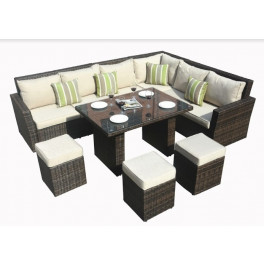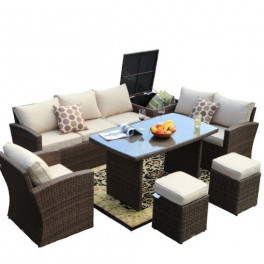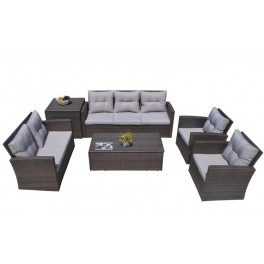There’s nothing like enjoying some fresh air in the spring and summer. You have friends over on the patio, relax in the garden, lie out on a chaise in the backyard… with a bird’s eye view of your neighbors’ deck and all the glory of their corndog barbecue family reunion. Suddenly, your backyard doesn’t feel like it’s your backyard anymore.
If you’re wondering how to make your yard and garden private, you’re definitely not alone. Most of us strive for a home environment that’s both relaxing and intimate. Luckily, there are numerous of outdoor sight barrier options to help you take back your space and create the comfortable sanctuary you expect on your own property.
1. Good Fences Make Good Neighbors
Tried and true, fences are the default choice for setting boundaries and maintaining privacy in outdoor areas. They are available in several different materials, such as wood, metal, and vinyl. There are pros and cons to different types of fencing, and a broad range of price points.
The most affordable type of fencing is probably cyclone (AKA chain link). Unfortunately, this alone will not provide much of a sight barrier. It’s generally intended to keep a property secure, whether from strangers entering, or small children and pets leaving. There are privacy add-ons for chain link fence, such as faux pine branches or aluminum strips that are woven through the links. Especially for large areas, this is a good cheap privacy fence option.
On the other end of the price spectrum is wrought iron. Though costly, wrought iron is made to last, and quite beautiful. It won’t, however, provide a complete sight barrier. One variation to achieve more privacy is a stone or brick wall of three to four feet topped with wrought iron fencing. Another option is filling out a wrought iron fence with climbing vines or roses. This strategy will work for a traditional wooden picket fence as well, and it’s a terrific front yard privacy fence idea.

Photo by xuanhuongho on Shutterstock
For a complete, one step sight barrier, go with a wooden privacy fence. They are called privacy fences for a reason. There are no spaces between slats, so there’s literally no view into your yard or garden. To keep a privacy fence from looking too institutional or nondescript, add a decorative element on top, such as fancy post caps or geometric cutouts. Flowers or shrubs planted along the interior edge can also help break up the landscape.
2. Hedge Your Bets
For more organic privacy, a hedge is a great choice. Hedges are basically a thicket of vegetation formed by close-growing bushes to create a total sight barrier. There are numerous kinds of hedges. Some are flowering, others are evergreen, and still others sport strikingly vibrant leaves. Juniper, boxwood, laurel, and privet are all good choices for hedge growing, but there are plenty of others. Check your hardiness zone before selecting plants and talk to your local nursery staff or other professionals for guidance with height, blooms and other considerations.

Photo by kavram on Shutterstock
On the plus side, hedges preserve your yard or garden as a green space and add to the natural beauty of your landscape. On the other hand, they require regular maintenance such as pruning, watering, and fertilization, and can take months or even years to become established. If you’re patient and enjoy gardening pursuits, hedges may be a good match for your yard.
Another popular form of privacy landscaping is a shrub garden with tiered plantings. The shortest plants form the lowest tier, with taller plants behind them, then taller shrubs and possibly small trees in the rear. Tiered plantings will not create the impermeable barrier that a hedge does. But if spaced properly, well-chosen bushes, flowering plants, and ornamental grasses can block the view from your neighbor’s property quite effectively and beautifully. If you have a low-lying property, try adding height with a berm, or small hill. Raising shorter plants up by even one or two feet can make a big difference in creating a successful sight barrier.

Photo by Elena Elisseeva on Shutterstock
3. Put Down Roots
Another plantable sight barrier is bamboo. If you want something thick and fast growing that can mature within a single season, bamboo is your go-to privacy landscaping plant. It comes in a bunch of varieties, with stalks and foliage in all shades of green and yellow, and many bamboo plants are winter hearty. Be careful when selecting your type, because many bamboos propagate by putting out runners. This means that long roots grow horizontally under the soil, allowing new shoots to pop up several feet or more from the original plant. Bamboo can tough to corral once it gets going and can take over large areas quickly.

Photo by inigocia on Despositphoto
If you don’t have a large space that you’re looking to fill, go with a clumping variety. They don’t put out runners and are much easier to contain. Be sure to ask your local nursery exactly what to expect from each variety before you buy, so you don’t wind up bamboozled with more plants than you can handle! Another idea is using potted bamboos, or other tall plants, to create a private area in your yard or garden.
Trees, of course, are also an option, but involve several challenges. If planted when mature, they can be extremely expensive, and should be done by a professional who will protect your investment with proper care. It’s far more affordable to plant younger trees, even saplings, but then you have to wait for them to grow. For some shade trees, it can take decades to achieve the desired height. Pines and fruit trees tend to be comparatively fast growers if your heart is set on establishing a tree line from scratch. Before purchasing or planting any trees on your property, look into local ordinances for height restrictions. It’s better to know before you grow!
4. Go High
If your property sits below your neighbors’, or the view into your yard is primarily from a raised deck, consider a shade structure. A gazebo, pergola or arbor will not only provide some cover on the sides but also from above, providing privacy from two-story neighbors. You can opt for a design with a solid or slatted roof, a canopy, and in some cases even curtains. And you don’t necessarily have to hire a contractor—DIY prefabricated options are available at Lowe’s, Home Depot, Amazon and various other vendors.

Photo by Gordon Swanson on Shutterstock
Climbing vines such as morning glory, clematis, and honeysuckle are ideal additions to any of these structures. If you decide to work trailing plants into your privacy landscape, again, check your hardiness zone first and select varieties that will grow well in your region. If your structure is over a brick or stone patio, not to worry. You can plant vines in pots to get a similar effect.
If you prefer to keep an open landscape, a large umbrella or shade sail may be the best solution for you. This is also a cost-effective solution to block neighbors’ aerial views. Patio, lawn, and garden areas are options for the partial shade of either an umbrella or shade sail, both of which are easy to install. Umbrellas are no longer tied to tables. They are available in round and rectangular shapes and a wide range of sizes and bases. Shade sails just need to be tied off, on three corners if triangular, four if rectangular or square. A tree, deck post, fence, or even an eye hook installed in your home’s siding can serve as an anchor for a shade sail. And as far as inexpensive backyard privacy ideas, this one tops the list.

Photo by Delpixel on Shutterstock
5. Privacy in an Instant
If you’re looking for a quick fix, consider backyard privacy screens and panels, especially if you only want to provide cover around a patio, in a corner of your yard, or other small- to mid-sized area. If you’re seeking cheap fencing options solely as a visual barrier, these may be better choices.
Privacy screens are most often made of natural materials like jute, bamboo, reeds, or wood. They can be installed in various ways, such as hanging (like a window shade) on the side of an open outdoor structure, or wired or bolted up between posts, similar to a fence. Wooden lattice privacy screens are probably the most common. Freestanding tensile fabric screens have super simple set up—just position the footed post on one side, and pull the other post to extend the screen, set it down, and voila! Privacy screens are an affordable option, costing less than pretty much any fence, even cyclone fencing.

Photo by hel080808 on Dreamstime
Freestanding panels are more expensive than screens but require next to no work to install. Simply unfold them where you want them — in a corner, on your patio or deck, or in the garden for instant view-blocking privacy. Well made panel screens can be wooden or metal, and are sufficiently weighted in the base to keep them in place in any weather. Some are completely solid. Others may be latticed or planked with spaces. As with other outdoor structures, panels are generally good bases for climbing vines. They can also be dressed up with ground plantings, or hanging plants and other décor.
Pulling It Together
If you can’t seem to nail down a favorite strategy, remember that you can mix and match. Maybe a picket fence with tiered plantings will do the trick for you, or a shade sail over a half screened patio. Making your personal outdoor oasis a reality is a balance of blueprinting, budgeting, and executing. And it will all be worth it when you see the results… instead of your neighbors!

























